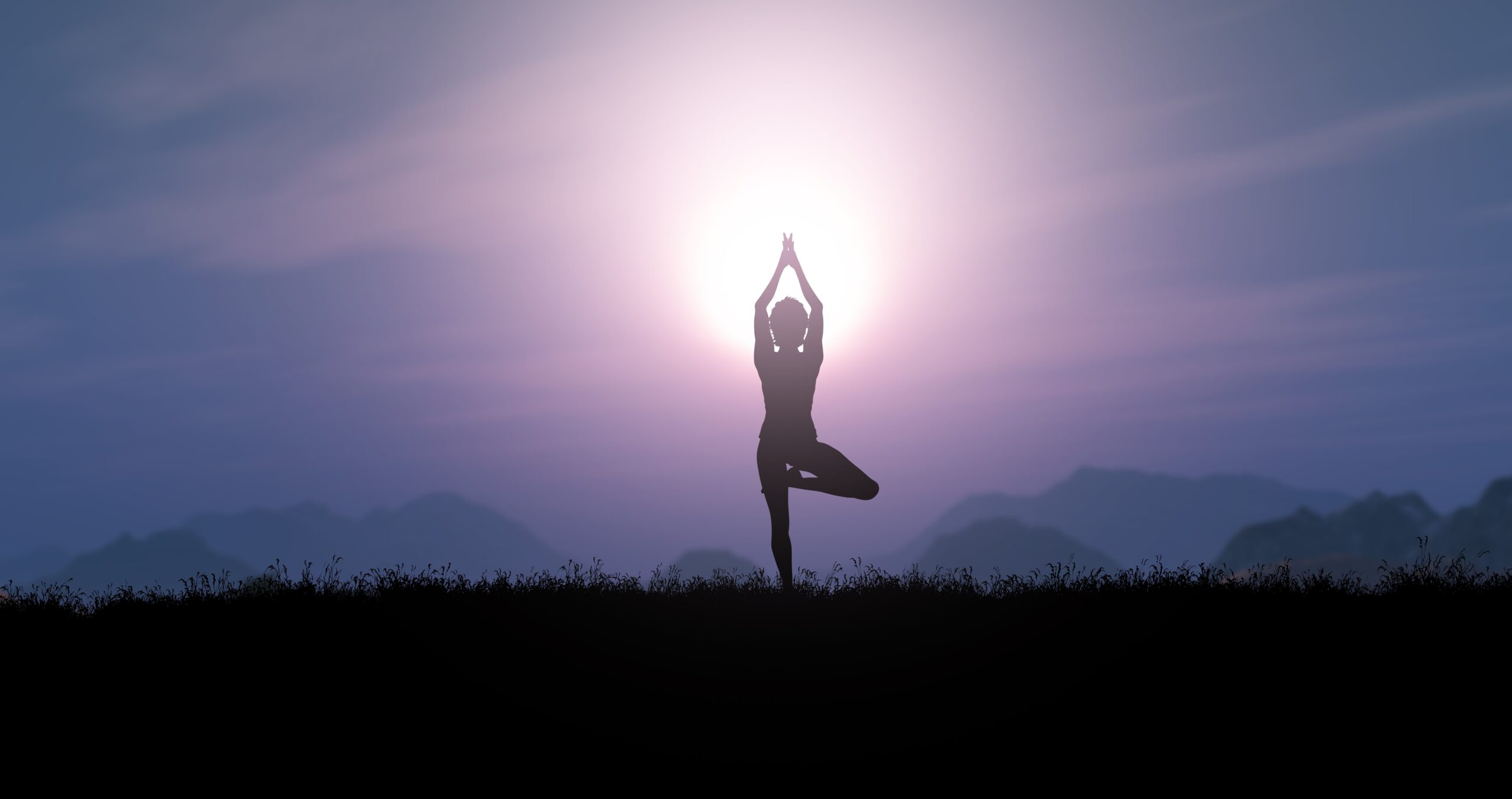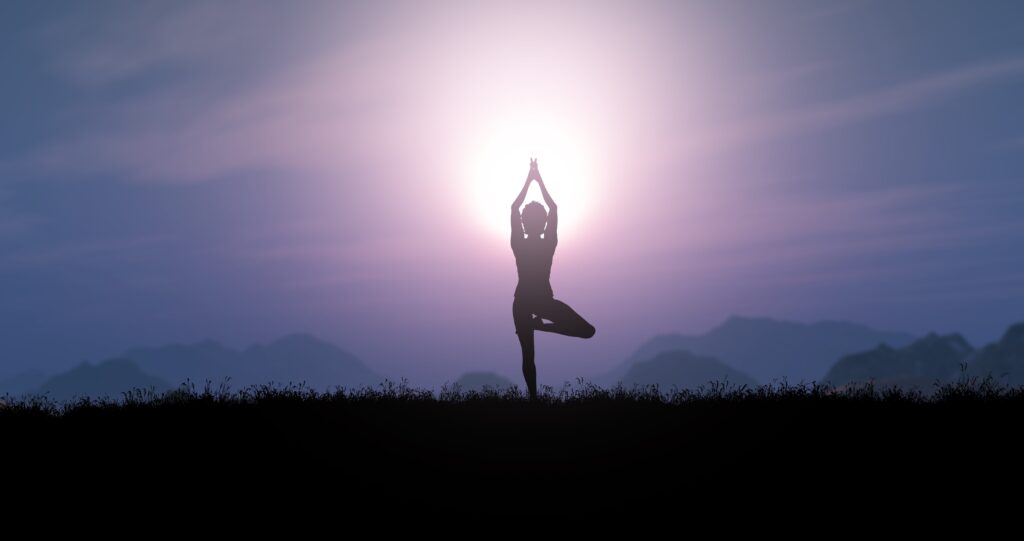
Yoga is a centuries-old practise that is still followed religiously by many for its numerous benefits, ranging from self-esteem building to inducing peace and relaxation. Over time, the practise has evolved, with more modern interpretations adding to the already diverse range of poses and forms. Add to that, if you are a Yoga newbie, there are a number of things to consider before getting serious about it- which poses are appropriate for you, if your form is correct, how long to hold each pose, and so on. It can be a little intimidating at first but never say never. Roll out your yoga mat and get ready as we bring to you seven easy yoga poses to get you started on your Yoga journey..
Mountain Pose (Tadasana)
How to do it:
- Stand with your feet parallel to each other. Let the two big toes of each foot touch each other while the heels of the feet stay apart. Now lift your toes and spread them widely. Distribute your weight equally on each foot so that you don’t lean back or forward.
- Engage your quadriceps (the muscles at the front of your thigh) and lift your kneecaps. Make sure your kneecaps don’t stay completely locked. The spine should remain straight resting directly over the tailbone.
- Inhale and elongate your core, pressing the crown of your head towards the ceiling.Widen your collarbones, bringing your shoulder blades up and then back down together. Lift the top of your sternum toward the ceiling without pushing your ribcage forward.
- The arms should be left relaxed on either side with the palms facing outwards.
- Hold this pose for about 30-60 secs with deep breaths throughout before letting your shoulders roll back down and returning to the original position.
Benefits: As easy this pose may seem, it demands deeper focus and engagement of every body part with further practice. This pose helps relieve sciatic pain, manage back pain, improve breathing, concentration and body posture among many other things.
Child’s pose (Balasana)
How to do it:
- Sit on your knees and keep your knees wide apart. Let the two big toes of each foot touch each other. Rest your buttocks on your heels.
- Sit up and Inhale. Lengthen your spine with the crown of your head reaching towards the ceiling.
- On exhalation, bow forward while tucking the torso between the two thighs. Bow forward until the forehead the touches the floor. Extended and elongate your arms with the palms touching the floor.
- Take deep breaths in this position while slowly stretching your spine and elongating your core by letting your fingertips reach forward. Keep your buttocks on your heels by pushing back slightly with your hands.
- Hold this pose for 10-30 seconds, keeping your gaze towards the floor and eyes closed. Maintain soft breaths.
- Return to your original pose by letting your hands push you back until you are sitting on your heels.
Benefits: Practicing this asana 3-5 times a day can help increase concentration, ease anxiety and stress and improve blood supply to the head thus nourishing the eyes and functions of the brain.
Cat/Cow Pose (Chakravakasana)
How to do it:
- Start with on your all fours. Make sure the wrists lay parallel to the shoulder’s above and the knees lay parallel to the hips. The spine should be in a neutral position. The neck kept long by first looking down and then up.
- Inhale and start with the cow pose while taking deep breaths. The position shall change gradually starting from the bottom to the up. First, tilt your pelvis up so that the tailbone faces the ceiling. This will let your spine bend in while allowing the belly to sink and pushing your chest forward. Gently take your gaze up without bending your neck.
- On exhalation, return to to the spine in neutral position.
- Upon inhaling again, begin with the cat pose while taking deep breaths throughout. Like the cow pose, the bodyshall follow the same sequence, that is from bottom to up. Tilt your pelvis down, tucking in your tailbone. The spine will naturally become round at this. The belly should be sucked in. Push your chest backwards. Drop your head and try to gaze at your navel.
- On exhalation, return to the neutral position slowly while taking soft breaths.
Benefits: As a breath syncronized movement, this asana has many benefits with much of it primarily benefitting the spine. It helps in improving spine and leg flexibility. Further practice can help relieve lower back pain and neck pain.
Downward Facing dog (Adho Mukha Shvasana)
How to do it:
- Start with on your all fours with the wrists aligned under the shoulder and the knees aligned under the shoulders. Spread your palms and fingers and place them firmly on the ground.
- Move your hands slightly forwards of your shoulders. Make sure to put the pressure on the edges of your hands and the fingertips.
- On exhalation, curl your toes inwards, push through your hands shifting the belly towards the legs. Lift your hips and straighten your legs until you form an upside down V- pose.
- The upper arms should be rotated outwards, widening the collarbone. Engage your forearms and quadriceps and begin to slow shift the weight on your arms towards your legs.
- Hold this position for 5-10 deep breaths, while slowly straightening your legs, while your heels are kept firmly planted on the floor. Keep pushing your pelvis up, while straightening your spine throughout.
- Exhale and slowly bend your knees to return to our initial position.
Benefits: As an extension of the Surya Namaskara flow, the downward dog is excellent for relieving stress and increasing concentration. It also helps in toning you shoulder, arms and upper back. If you want a strong core and back this is your go to asana.
Tree Pose (Vrikshasana)
How to do it:
- Stand with your feet adjacent to your shoulders. The feet should be firmly planted on the ground, and the body weight should be evenly distributed.
- Focusing the weight on your right leg, slowly bend your left leg placing the sole of the left foot on the inner right thigh.
- Press your left foot and your right thigh against each other so that balance is maintained and the pelvis is squared to the front.
- Make sure not to lock your right kneecap, draw your shoulder blades back and bring your hands together at the heart or join them overhead slowly. Fix your gaze on something stable and hold the pose for 5-10 breaths.
- On exhalation, release the pose and return to the original standing pose.
- Inhale and begin again with the other side.
Benefits: This posture resembling the erect stance of a tree is best for improving concentration of the mind. It helps tone the leg muscles and improve balance. It even helps strengthen ligaments of the ankle and feet.
Triangle Pose (Trikonasana)
How to do it:
- Start by standing on your two feet. The distance between the two feet should be slightly wider than your shoulder width.
- Turn your left feet and bend the left leg while moving to the body towards that direction. Simultaneously extend your hands horizontally making a ‘T’. Rotate your head towards the direction of your body.
- Straighten your left leg and slightly bend your torso over the leg. Turn your left arm with the palm facing the ceiling.
- Gradually, bend at the torso until the left palm is firmly placed on the floor, infront of your left foot. Maintain a long straight spine while bending and ensure your left leg is stretched straight. Bring your right arm directly overhead and turn your head towards it.
- Hold the pose for several deep breaths before exhaling and returning to the original ‘T’ position.
Benefits: It helps open your hips and shoulders, increase concentration, increase stability, stimulates the organs and reduce stress.
Crescent Lunge pose (Anjanayesana)
How to do it:
- Begin by getting in on all your fours. Bring the right foot slightly forward between your hands.
- Bend your knee at a 90° angle, with your knee aligned directly over your right foot and the right shin perpendicular to the floor.
- Lift your arms together slowly overhead with the palms facing in. This helps in bringing the shoulder blades together and straightening the sternum so that the ribs don’t budge forward. Lift the arms from your lower back.
- Make sure the spine does not curve completely. The tailbone should be directly facing the floor and the reach through your fingers your gaze fozused on your thumbs. Hold the pose for 30-60 seconds.
- On exhalation, release the arms slowly bringing them to the side and placing them on the floor again while bringing the right foot back along the left foot and starting again with the other side.
Benefits: This pose has numerous advantages which means all the more reason to start doing it. It helps improve balance, stretches the hip and opens the hip flexors, strengthens the gluteus maximus, calves and arms.


